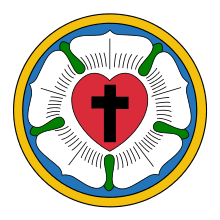Haugean

Adolph Tidemand (1852)
| Part of a series on |
| Lutheranism |
|---|
 |
|
Bible translators
|
|
Theologians |
|
|
The Haugean movement, or Haugeanism (Norwegian: haugianere), was a pietistic state church reform movement intended to bring new life and vitality into the Church of Norway which had been often characterized by formalism and lethargy.[1]
Background
The Haugean movement took its name from the lay evangelist Hans Nielsen Hauge. It played an important part in nurturing the democratic folk movement of the time, and stimulating the entrance into politics of representatives of the rural population. It increased tensions between the more privileged classes and the common people, as well as between the clergy and the laity.[2][3]
Hans Nielsen Hauge worked as a lay preacher at a time when such activity was forbidden by law. The Conventicle Act of 1741 prohibited any religious meetings not authorized by the state church: a response to radical Pietism within Norwegian cities. The act decreed that religious gatherings could be held only under the supervision of a state approved minister. The pastor was thought to be the only person who could correctly interpret the teachings of the Norwegian State Church. The ministers had the sole right to administer the sacraments, and as a public official he was accountable to the state for the Christian indoctrination of his flock.[4][3]
Hauge came to feel that he had a divine call which made it mandatory for him to break this law and proclaim the word of God directly among his fellowmen. He advocated a priesthood of all believers. He felt that people had to be awakened to a consciousness of their sins before they could begin to gain salvation through the grace of God. According to Hauge’s views, the State Church failed to provide parishioners with a personal religious experience. Hauge’s religious teachings were therefore viewed as attacks on the state church and its ministers.[5]
Impact
The teachings of Hauge had considerable influence with Norway. Within commerce, many Haugeans launched industry initiatives, such as mills, shipyards, paper mills, textile industry and printing house. Within political activities, three Haugeans were in attendance at the National Assembly at Eidsvoll in 1814. [6]
Within popular culture, the character Solveig in Peer Gynt (1876) by Henrik Ibsen is presented as a member of a Haugean family, and this religious affiliation is clearly related to her purity and steadfast love for the play's protagonist. Bjørnstjerne Bjørnson's work Synnøve Solbakken (1857) also presents the heroine as a Haugean with similar purity and commitment to her eventual betrothed, Thorbjørn. A vivid picture of Haugeans appears in the novels of Alexander Kielland. Adolph Tidemand portrayed Hauge and his followers in the painting Haugianere (1852).[7][8][9]
The influence of Hans Nielsen Hauge within Norway coincided with the years during which many Norwegians were immigrating to North America. The Haugean influence on Lutheranism in America has been considerable. The Lutheran Church in America had a Hauge Synod, Eielsen Synod and Lutheran Free Church all indicative of that influence. Hauge is remembered on the liturgical calendar of the Evangelical Lutheran Church in America on March 29th as one of the Renewers of the Church.[10]
See also
References
- ↑ Page 15 Report of the Annual Meeting of the Haugean Churches Held at Lisbon, Illinois, in June, 1854 translated and edited by J. Magnus Rohne. Norwegian American Historic Association. Volume IV:
- ↑ Hans Nielsen Hauge (1771 - 1824): Lay evangelist and leader of a religious awakening in Norway Global Christianity, Luther Seminary
- 1 2 From revolt to hegemony Tysvær Local History Book. Volume 9; Such as They Lived, Svein Ivar Langhelle, Tysvær kommune, Rogaland, Norway, 1997, translation by Rotraud Slogvik, 2002
- ↑ Page 3 The Norwegian Immigrant and His Church Eugene L. Fevold, Norwegian-American Historic Association. Volume 23
- ↑ Hans Nielsen Hauge, Lay-Preacher And Social Reformer Per Gjendem Historieportal
- ↑ Nils Egede Bloch-Hoell. "haugianere". Store norske leksikon. Retrieved March 10, 2016.
- ↑ Semmingsen, Ingrid Gaustad. Norwegian Emigration to America During the Nineteenth Century. Norwegian-American Historic Association. Volume XI: Page 66.
- ↑ Magnus, Alv Johan (1978). Revival And Society: An Examination of the Haugean Revival and its Influence on Norwegian Society in the 19th Century. Magister Thesis in Sociology at the University of Oslo.
- ↑ Soltvedt, Susanne (1999) Hans Nielson Hauge: The Influence of the Hauge Movement on Women of Norway. Murphy Library, University of Wisconsin, La Crosse, Undergraduate Research.
- ↑ Page 66 Norwegian Emigration to America During the Nineteenth Century Ingrid Gaustad Semmingsen, Norwegian-American Historic Association. Volume XI:
Other Sources
- Amundsen, Arne Bugge (1997) The Haugean Heritage – a Symbol of National History (from "In Search of Symbols. An Explorative Study" Jens Braarvig & Thomas Krogh,editors, pp. 214–233. Department of Cultural Studies, University of Oslo)
- Eielsen, Sigrid (2000) A Haugean Woman in America : the Autobiography of Sigrid Eielsen (Norwegian-American Historical Association. Northfield, Minn., vol. 35)
- Gjerde, S. S. & Ljostveit, P. (1941) The Hauge Movement In America (The Hauge Inner Mission Federation)
- Wee, Mons Olson (1919) Haugeanism: A Brief Sketch of the Movement and Some of Its Chief Exponents (Harvard University)